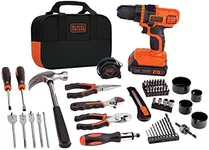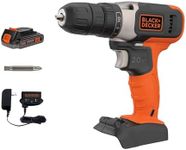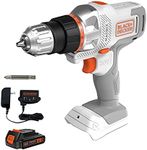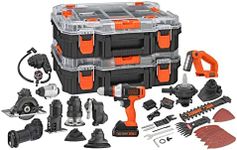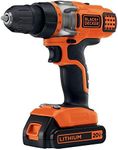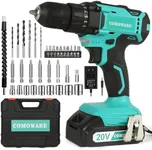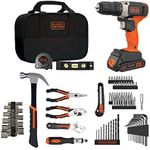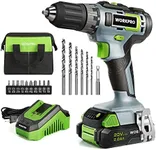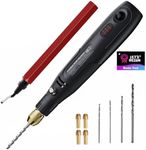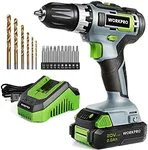Buying Guide for the Best Black And Decker Drill
When choosing a Black and Decker drill, it's important to consider several key specifications to ensure you select the right tool for your needs. Drills come with various features and capabilities, and understanding these can help you make an informed decision. Here are the main specs to consider and how to navigate them.Power SourceDrills can be either corded or cordless. Corded drills are typically more powerful and don't require recharging, making them ideal for heavy-duty tasks and continuous use. Cordless drills offer greater mobility and convenience, as they are battery-powered and can be used anywhere without the need for an electrical outlet. If you need a drill for light to medium tasks around the house, a cordless model might be more suitable. For more demanding projects, a corded drill could be the better choice.
VoltageVoltage is a measure of the power output of a cordless drill. Higher voltage means more power and the ability to handle tougher materials. Common voltages range from 12V to 20V. For light tasks like assembling furniture or drilling into softwood, a 12V drill is usually sufficient. For more intensive tasks like drilling into hardwood or metal, a higher voltage, such as 18V or 20V, would be more appropriate.
Chuck SizeThe chuck size determines the maximum diameter of the drill bit that the drill can hold. Common sizes are 3/8 inch and 1/2 inch. A 3/8 inch chuck is suitable for most household tasks and light-duty work. A 1/2 inch chuck is better for heavy-duty tasks and larger drill bits. Consider the types of projects you plan to undertake when choosing the chuck size.
Speed SettingsDrills can have single or multiple speed settings. Single-speed drills are simpler and usually sufficient for basic tasks. Multi-speed drills offer more versatility, allowing you to adjust the speed for different materials and tasks. For example, lower speeds are better for driving screws, while higher speeds are ideal for drilling holes. If you need a drill for a variety of tasks, a model with multiple speed settings would be beneficial.
TorqueTorque is the rotational force the drill can apply. Higher torque is necessary for driving screws and drilling into harder materials. Drills with adjustable torque settings allow you to control the amount of force applied, which is useful for preventing overdriving screws or damaging materials. If you plan to use the drill for a range of tasks, including driving screws, look for a model with adjustable torque settings.
Battery LifeFor cordless drills, battery life is a crucial factor. Longer battery life means you can work longer without needing to recharge. Consider the type of battery (Lithium-ion batteries are common and offer longer life and quicker charging times) and the amp-hour (Ah) rating, which indicates the battery capacity. Higher Ah ratings mean longer battery life. If you have long projects or frequent use, opt for a drill with a higher Ah rating.
Weight and ErgonomicsThe weight and design of the drill affect how comfortable it is to use, especially for extended periods. Lighter drills are easier to handle and reduce fatigue, but they may also be less powerful. Ergonomic designs with comfortable grips can make a big difference in usability. If you plan to use the drill for long periods or have limited strength, look for a lightweight, ergonomically designed model.

